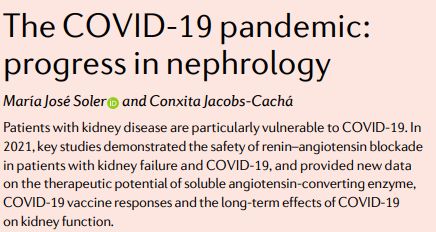New drugs for chronic kidney disease are desired
Between 9 – 12% of the worlds population suffers from Chronic Kidney Disease (CKD), but with no cure, how can we develop more effective therapies for this underserved population?
Last year, the following article was published in Nature Reviews Nephrology (Soler et al., Nature Reviews Nephrology., 2021).
The COVID-19 pandemic: progress in nephrology

The long-term decline in renal function as a complication of COVID-19 has also drawn attention to renal disease.
–What is chronic kidney disease?
CKD is a persistent loss of kidney function and structural abnormalities that are assessed using markers of kidney damage and histological analysis.
As the disease progresses, it can lead to a variety of complications. Millions of people in the United States suffer from life-threatening complications related to chronic kidney disease each year, and it has been reported that less than 1% of the population suffers from CKD, which accounts for more than 6% of annual healthcare costs.
–The pathogenesis of chronic kidney disease
Renal diseases can be divided into glomerular diseases and tubular/interstitial diseases according to the location of the lesions.
Although there is a common decline in renal function and abnormalities in the structure of the kidney, there are differences in the causes, the location of the lesions and the markers found.
Therefore, when we are asked to conduct efficacy studies, we are often asked about the location of the lesions and the renal markers observed, depending on the client’s target.
To date, there is no cure for CKD and treatment is aimed at delaying the progression of the disease and reducing its severity. Therefore, it is desirable to develop a radical drug for the treatment of chronic kidney disease.
